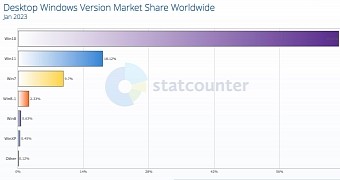Windows 7 and Windows 8.1 have already been abandoned by Microsoft, and now users still running these operating systems have no other option than to upgrade to a newer version of Windows.
The support for Windows 7 was originally dropped in January 2020, but the platform then entered the Extended Security Update phase where Microsoft provided security updates exclusively to paying customers.
After three years of ESU support, Windows 7 waved the final goodbye to the world in January this year, with Microsoft, therefore, letting this OS version behind once and for all.
In the case of Windows 8.1, Microsoft adopted a different strategy, as no ESU program was available for this OS version.
And while both Windows 7 and 8.1 are now unsupported platforms, new statistics provided by StatCounter show that the two operating systems continue to hold a significant share in the Windows world.
Data for the month of January show that Windows 10 is still the number one version with a market share of 68.64 percent, followed by Windows 11 with 18.12 percent. The adoption of Windows 11 appears to be making slow progress, but this isn’t necessarily surprising given the software giant updated the system requirements and only new devices are allowed to run it.
The third place goes to Windows 7, which is currently running on 9.7 percent of the computers out there. This is impressive for an operating system launched in 2009 and abandoned for home users in 2020, there’s no doubt about it. Windows 8.1 is next with 2.33 percent.
Many users out there still running Windows 7 and 8.1 don’t seem to be concerned with the security risks involved in using an unsupported version of Windows.
After all, Microsoft itself confirmed that the two operating systems would continue to run normally, only that they would no longer receive fixes and security patches. This means you should be able to use your computer just like before, only that the likelihood of exploits that would expose your data is now significantly higher.
“As a reminder, Windows 8.1 has reached end of support on January 10, 2023. At this point, technical assistance and software updates will no longer be provided. If you have devices running Windows 8.1, we recommend upgrading them to a more current, in-service, and supported Windows release. If devices do not meet the technical requirements to run a more current release of Windows, we recommend that you replace the device with one that supports Windows 11,” Microsoft said regarding Windows 8.1.
In the case of Windows 7, Microsoft says the best option is to purchase a new computer that runs Windows 11, and without a doubt, this is one of the reasons this OS version continues to remain so popular in the Windows user base.
As far as Windows 8.1 is concerned, moving to Windows 10 or Windows 11 might actually be possible if the hardware requirements are met.
“Windows 10 is still available and will be supported until October 14, 2025. You can check if your current PC meets the minimum system requirements for Windows 10. If it does, you can purchase and download a full version of Windows 10 Home or Windows 10 Pro. You can also check with retailers to see if they still offer Windows 10 for sale,” Microsoft says.
At the end of the day, one thing is clear: killing off Windows 7 and Windows 8.1 will take longer than expected, especially due to the changes that happened in the Windows world with the release of Windows 11. The upgraded system requirements are likely to make many users stick with their devices for much longer, and this includes running an outdated OS version as well.

 14 DAY TRIAL //
14 DAY TRIAL //